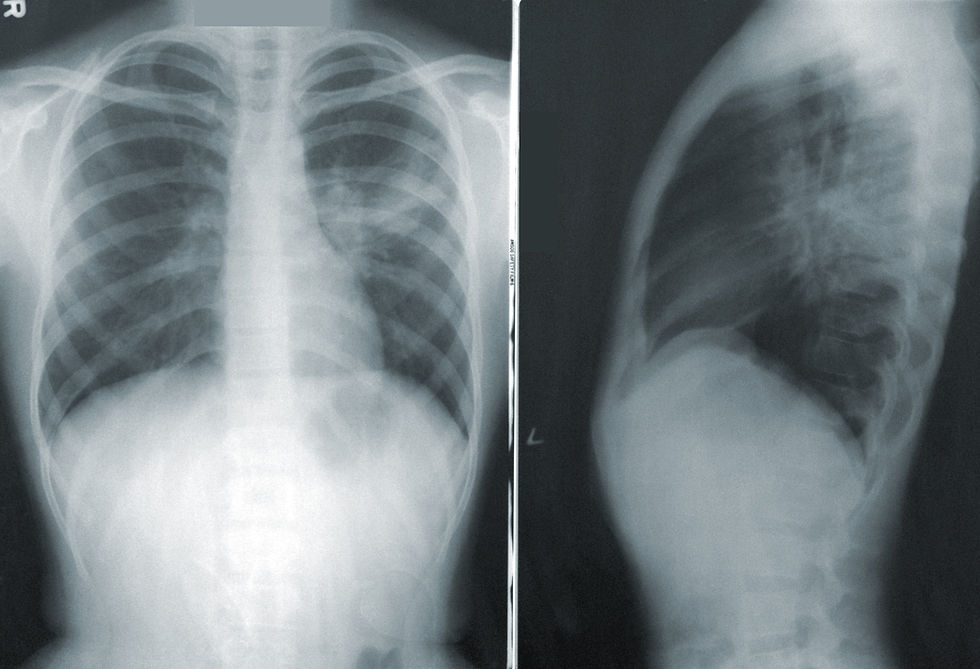🫁 When a Cold Turns Dangerous: Understanding Secondary Pneumonia After Viral Infections
- Eric Han
- 6 days ago
- 4 min read

As cold and flu season ramps up, many people expect a sore throat, congestion, or fatigue to last a week or two — then fade away. But sometimes, that’s not how the story ends.
In certain cases, a simple viral infection can pave the way for something much more serious: secondary bacterial pneumonia. With rising vaccine hesitancy and a strained healthcare system, this complication is becoming more relevant — and more preventable — than ever before.
🌡️ What Is “Secondary” Pneumonia?
Pneumonia means infection of the lungs.
A primary pneumonia happens when a virus or bacterium directly infects lung tissue.
A secondary pneumonia occurs after another illness — most often a viral infection like influenza, RSV, or COVID-19 — weakens the body’s defenses.
When a virus attacks the respiratory tract, it:
Damages the delicate cells that line the airways,
Paralyzes the tiny cilia that normally sweep out mucus and debris, and
Disrupts the immune balance in the lungs.
This creates the perfect environment for bacteria that normally live harmlessly in the nose or throat (such as Streptococcus pneumoniae or Staphylococcus aureus) to move down into the lungs and multiply.
🧬 Why It Happens — The Two-Hit Theory
Doctors often describe secondary pneumonia as a “two-hit” process:
First hit: a viral infection (like the flu or COVID-19) injures the airway and suppresses local immunity.
Second hit: bacteria take advantage of the damaged surface and reduced immune defenses, causing bacterial pneumonia days or weeks later.
People often start to feel better from their virus — then suddenly worsen again with fever, chills, cough, or shortness of breath.That “double dip” in symptoms is a red flag.
🚨 Who’s Most at Risk?
Secondary pneumonia can strike anyone, but certain groups are more vulnerable:
Adults over 50, especially those with chronic illnesses (heart, lung, or immune conditions)
People with diabetes or obesity
Those with asthma or COPD
Individuals who are unvaccinated for flu, COVID-19, or pneumococcal disease
People with limited access to healthcare or who delay seeking care
During viral surges, these patients often face long waits for evaluation or antibiotics — making timely prevention even more important.
💉 Vaccines: The Overlooked Shield
The irony is that secondary bacterial pneumonia is largely preventable.
Two vaccine groups play complementary roles:
1. Viral Vaccines
Vaccines for influenza and COVID-19 prevent the initial viral “first hit.”Even when vaccinated people get sick, their illness tends to be milder — and less likely to damage the lungs enough to allow bacterial invasion.
2. Pneumococcal Vaccines
Vaccines like PCV20 or PPSV23 target Streptococcus pneumoniae, the bacteria most often responsible for post-viral pneumonia.Adults 50 and older — and younger adults with chronic health issues — are candidates.Receiving both flu and pneumococcal vaccines significantly lowers hospitalization and mortality risk from pneumonia.
⚠️ The Growing Challenge: Vaccine Hesitancy and System Strain
Unfortunately, vaccine uptake has dropped in many communities.
In the United States:
Flu vaccine coverage fell below 50% in adults in recent years.
Pneumococcal vaccination rates remain under 30% in eligible adults.
Misinformation about COVID-19 and vaccine safety continues to fuel distrust.
At the same time, healthcare systems are stretched thin — with fewer primary care visits, overwhelmed emergency departments, and staffing shortages.That means people are more likely to delay care when a simple viral infection worsens, giving secondary pneumonia time to take hold.
🩺 Recognizing the Warning Signs
Seek medical attention if, after a viral illness, you experience:
Fever that returns or worsens after initial improvement
Shortness of breath or rapid breathing
Chest pain or heaviness
Cough with colored or bloody sputum
Fatigue far worse than expected
Early diagnosis and antibiotics (when bacterial infection is confirmed or highly suspected) can prevent hospitalization or more severe outcomes.
🌟 The Takeaway
Secondary pneumonia is a complication we can often prevent.The best protection remains vaccination, early medical evaluation, and proactive health maintenance.
Even if you’re healthy and under 50, staying up to date with flu, COVID-19, and pneumococcal vaccines protects not only you, but also the people around you — especially those with weaker immune systems.
In a time when our healthcare systems are stretched and misinformation spreads faster than the viruses themselves, prevention truly is the most powerful medicine.
Bottom line:
Get your vaccines. Listen to your body. Don’t ignore that second wave of symptoms.Secondary pneumonia is preventable — but only if we act before it takes our breath away.
At Woodside Internal Medicine, we help protect our patients from serious respiratory infections. A simple cold or flu can sometimes lead to secondary bacterial pneumonia—but prevention makes all the difference. Our team offers flu, COVID-19, RSV and pneumonia vaccines.
Serving Carmel, Westfield, Zionsville, and the greater Indianapolis area.
Disclaimer:
This article is for educational purposes only and is not a substitute for professional medical advice, diagnosis, or treatment. Always seek the advice of your physician or other qualified healthcare provider with any questions you may have regarding a medical condition or before starting any new treatment or vaccination. Never disregard professional medical advice or delay seeking it because of something you have read here.




Comments